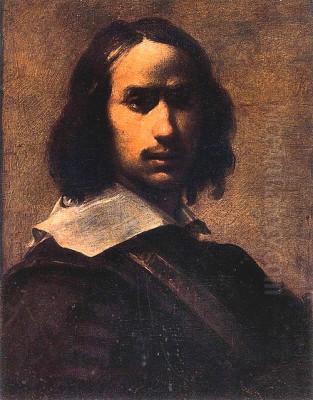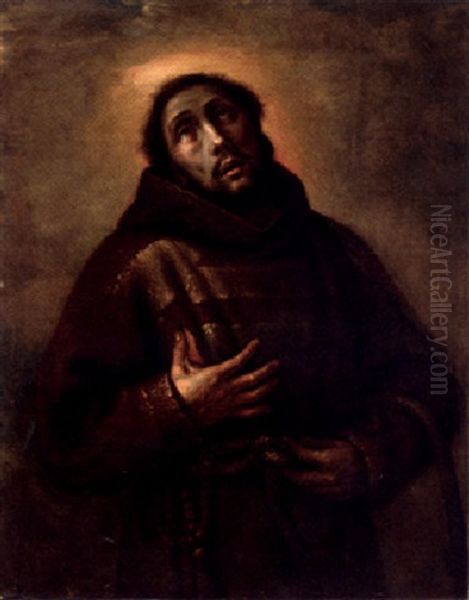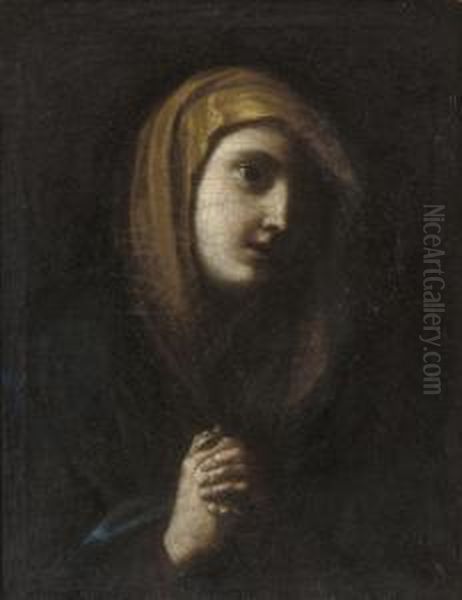
Francesco del Cairo stands as a significant, albeit sometimes enigmatic, figure within the vibrant tapestry of Italian Baroque painting. Active primarily during the first half of the 17th century, he carved a unique niche for himself, particularly within the artistic centres of Lombardy and Piedmont. His work is characterized by intense emotionalism, dramatic lighting, and a penchant for depicting moments of religious ecstasy, martyrdom, and profound psychological states. Honoured with a knighthood for his service, he navigated the complex artistic currents of his time, absorbing influences while forging a distinctive and often arresting style.
Origins and Early Influences in Milan
Born in Milan in 1607, Francesco del Cairo emerged into an artistic environment rich with tradition yet receptive to innovation. The precise details of his initial training remain somewhat obscure, a common circumstance for artists of this period. However, art historians concur that his formative years were significantly shaped by the prevailing artistic trends in Milan, particularly the influence emanating from the circle of Pier Francesco Mazzucchelli, known famously as Il Morazzone (1573–1626).
Morazzone was a leading exponent of the Lombard school of painting in the late 16th and early 17th centuries, known for his dramatic compositions, rich colour, and expressive figures, often depicting intense religious experiences. Alongside other prominent Lombard masters like Giulio Cesare Procaccini (1574–1625) and Daniele Crespi (c. 1598–1630), Morazzone contributed to a regional style that blended Mannerist elegance with the burgeoning emotional intensity of the early Baroque. Cairo absorbed this local flavour, evident in the dynamism and pathos found even in his early works. The legacy of earlier Lombard artists, including the naturalism explored by painters from the region, also provided a foundational context.
Court Painter in Turin: The Knight of Cairo

A pivotal moment in Cairo's career arrived in 1633 when he relocated to Turin. This move marked a significant step up in patronage and prestige, as he entered the service of Victor Amadeus I, Duke of Savoy. Turin, the capital of the Duchy of Savoy, was a centre of political and cultural importance, and the ducal court provided ample opportunities for ambitious artists. Cairo assumed the role of a court painter, a position that likely involved creating portraits of the ruling family and members of the court, as well as historical and allegorical works intended to glorify the Savoy dynasty.
His service at the Savoy court was evidently highly valued. In recognition of his contributions and artistic merit, Francesco del Cairo was awarded a prestigious honour, likely the Order of Saints Maurice and Lazarus, a chivalric order associated with the House of Savoy. This accolade earned him the moniker by which he became widely known: "Il Cavaliere del Cairo" – the Knight of Cairo. This title not only signified his elevated social standing but also served as a testament to his success and recognition within the competitive artistic landscape of 17th-century Italy. His time in Turin solidified his reputation and provided him with financial stability and access to influential patrons.
Roman Exposure: Encountering the Masters
Seeking to broaden his artistic horizons and engage with the epicentre of the Italian art world, Francesco del Cairo travelled to Rome around 1637-1638. This period, though perhaps relatively brief, was profoundly impactful. Rome in the late 1630s was a crucible of artistic innovation, dominated by the High Baroque style and still reverberating with the revolutionary impact of Michelangelo Merisi da Caravaggio (1571–1610).
During his stay, Cairo encountered the works of the leading figures of the Roman scene. He would have seen the grand decorative schemes and dynamic compositions of Pietro da Cortona (1596–1669), a key architect of the High Baroque style. He also likely studied the more classical, yet deeply felt, works of the Bolognese master Guido Reni (1575–1642), whose paintings were highly sought after throughout Italy. The pervasive influence of Gian Lorenzo Bernini (1598–1680), primarily a sculptor and architect but whose dramatic sensibility permeated Roman art, would also have been inescapable.

Crucially, Rome offered Cairo direct exposure to the powerful legacy of Caravaggio. Although Caravaggio himself had died nearly three decades earlier, his revolutionary use of chiaroscuro (dramatic light and shadow), his unflinching realism, and his focus on moments of intense human drama had spawned a generation of followers (the Caravaggisti) and fundamentally altered the course of European painting. Artists like Bartolomeo Manfredi (1582–1622) and later figures continued to explore Caravaggio's innovations. Seeing Caravaggio's masterpieces in Roman churches and collections undoubtedly left a deep impression on Cairo, reinforcing his own inclination towards dramatic lighting and psychological intensity. This Roman sojourn enriched his artistic vocabulary, adding layers of sophistication and dramatic power derived from the masters of the Baroque.
The Mature Style: Ecstasy, Pathos, and Dramatic Light
Following his experiences in Turin and Rome, Francesco del Cairo's mature style crystallized, revealing a unique synthesis of his Lombard roots and the broader Italian Baroque currents. He became particularly renowned for his depictions of intense religious experiences, often focusing on female saints and biblical heroines caught in moments of ecstasy, martyrdom, or profound grief. His approach was far removed from serene classicism; instead, he embraced a heightened emotionalism that could border on the unsettling or the macabre.
A hallmark of his style is the dramatic use of light and shadow, clearly indebted to Caravaggio and his followers. Light often falls sharply across his figures, emerging from deep, tenebrous backgrounds, highlighting key details – a face contorted in pain or rapture, a gesture of despair, the texture of fabric. This chiaroscuro enhances the theatricality of his scenes, focusing the viewer's attention and amplifying the emotional impact.
Cairo's figures themselves are often characterized by a fluid, almost "liquefied" quality, particularly in their expressions and postures. Faces are upturned, eyes rolling back, bodies sometimes seeming to dissolve in the intensity of their spiritual or physical suffering. This distinctive rendering contributes to the ecstatic, almost otherworldly atmosphere of many of his works. Critics have sometimes described his style as "frenetic" or "convulsive," pointing to the agitated energy that pervades his canvases. He also frequently employed exotic elements, such as elaborate turbans and rich textiles, adding a touch of the theatrical and the opulent to his religious narratives.
Notable Works and Commissions
Francesco del Cairo's oeuvre includes a range of works, from portraits executed during his time in Turin to numerous religious paintings that form the core of his reputation. Several key works exemplify his distinctive style and thematic concerns:

_Herodias with the Head of Saint John the Baptist_ (c. 1625-30, Museum of Fine Arts, Boston): This early masterpiece already showcases Cairo's penchant for dramatic and somewhat gruesome subjects. Herodias gazes intently, almost possessively, at the severed head presented on a platter. The lighting is stark, illuminating the pallor of the head and the rich fabrics, while plunging the background into shadow. The psychological tension is palpable, capturing a moment of morbid triumph and perhaps underlying disquiet.
_Judith Holding the Head of Holofernes_ (versions exist, e.g., Museo del Prado, Pinacoteca di Brera): Another popular Baroque theme, Cairo tackled the story of Judith beheading the Assyrian general Holofernes multiple times. These paintings often emphasize Judith's resolve mixed with a certain vulnerability or introspection, set against a backdrop of dramatic chiaroscuro. The contrast between the beautiful heroine and the grisly trophy is a recurring motif, handled by Cairo with his characteristic intensity.
_The Death (or Suicide) of Cleopatra_ (versions exist, e.g., Pinacoteca di Brera): Depicting the final moments of the Egyptian queen, Cairo focuses on the pathos and tragedy of her suicide. Influenced perhaps by Guido Reni's treatment of similar subjects, Cairo infuses the scene with a sense of impending doom and sorrowful resignation, often using soft modelling combined with dramatic lighting to highlight Cleopatra's beauty even in death.
_The Martyrdom of St. Euphemia_ (c. 1660, Private Collection): This work exemplifies Cairo's engagement with themes of martyrdom and suffering. St. Euphemia, an early Christian martyr, is shown enduring her fate with a mixture of pain and spiritual transcendence, typical of Cairo's exploration of extreme emotional states within a religious context.
Beyond these specific examples, Cairo undertook significant commissions for altarpieces. He painted works for the Certosa di Pavia, a major Carthusian monastery near Milan, contributing to its rich artistic decoration. He also created altarpieces for churches in Casalpusterlengo (likely Santo Stefano), Savigliano, and the church of San Salvario in Turin during his later return to the city. These larger-scale works allowed him to deploy his dramatic compositions and emotional figures within liturgical settings.
Venetian Interlude and Later Career
Around 1643 to 1646, Francesco del Cairo spent time in Venice. The city of canals, while perhaps past the absolute zenith achieved by masters like Titian (c. 1488/90–1576), Tintoretto (1518–1594), and Veronese (1528–1588), remained an important artistic centre with its own distinct traditions. The Venetian emphasis on rich colour (colorito) and atmospheric effects offered a different sensibility compared to the more drawing-focused (disegno) traditions of Central Italy or the starker drama often found in Lombardy.
During his Venetian stay, Cairo painted an altarpiece depicting Saint Teresa for the church of San Carlo (the exact church sometimes debated, but often associated with the Discalced Carmelites). This period may have subtly influenced his palette or handling of light, potentially softening some of the harsher chiaroscuro evident in his more overtly Caravaggesque works. He would have encountered the works of contemporary Venetian painters such as Pietro Liberi (1605–1687) or Sebastiano Mazzoni (c. 1611–1678), who were navigating the legacy of the 16th-century giants while engaging with Baroque trends.
Following his time in Venice, Cairo returned to Piedmont, undertaking further commissions in Turin between approximately 1646 and 1649, including the altarpieces for Savigliano and San Salvario. His later career saw him continue to work primarily in Lombardy. He remained an active and respected painter, working alongside or influencing the next generation of Lombard artists, such as Carlo Francesco Nuvolone (1609–1662), who also blended influences from Morazzone, Guido Reni, and others. Francesco del Cairo passed away in Milan in 1665, leaving behind a substantial body of work.
Legacy: A Distinctive Voice in the Baroque
Francesco del Cairo occupies a unique position within the landscape of 17th-century Italian art. He was fundamentally a Lombard painter, deeply rooted in the regional traditions exemplified by Morazzone. However, his travels and exposure to the dominant artistic forces of his time – particularly the dramatic realism of Caravaggio and the High Baroque energy of Rome – significantly shaped his development. He skillfully integrated these influences into a highly personal style, characterized by its emotional intensity, theatrical lighting, and focus on moments of spiritual and psychological extremity.
While perhaps not as widely influential as Caravaggio or Bernini, Cairo was a master in his own right, particularly adept at conveying pathos and ecstasy. His work stands apart for its sometimes unsettling, almost feverish quality, pushing the boundaries of emotional expression within religious art. He represents a specific, potent strain within the broader Baroque movement, one that prioritized visceral impact and psychological depth. As "Il Cavaliere del Cairo," he achieved contemporary recognition, and his paintings continue to compel viewers with their dramatic power and unique vision. His legacy lies in this distinctive contribution to the rich diversity of the Italian Baroque.